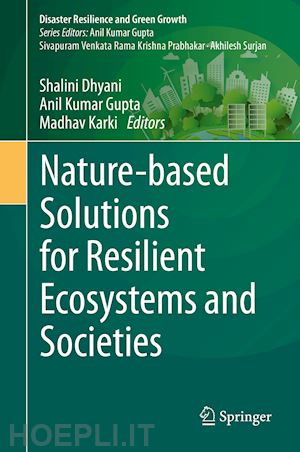
Questo prodotto usufruisce delle SPEDIZIONI GRATIS
selezionando l'opzione Corriere Veloce in fase di ordine.
Pagabile anche con Carta della cultura giovani e del merito, 18App Bonus Cultura e Carta del Docente
Dr. Shalini Dhyani is a Senior Scientist with the Critical Zone Group, Water Technology and Management Division of the CSIR-NEERI, India. She is the S. Asia Regional Chair for the IUCN Commission on Ecosystems Management (CEM) and Lead Author of the Global Assessment on Sustainable use of Wild Species (2018-2021) by Intergovernmental Science-Policy Platform for Biodiversity and Ecosystem Services (IPBES). Dr. Shalini has been working tirelessly to integrate and mainstream biodiversity and Nature-based Solutions in decision-making and policy planning.
Dr. Anil Kumar Gupta is a Professor and Head of the Environment, Climate and Disaster Risk Management Division and International Cooperation at the National Disaster Management Institute based in New Delhi. Dr. Gupta is known for pioneering contributions to climate change adaptation integration, including disaster management, concepts for and promotion of environmental sustainability, and ecosystem-based approaches to resilience and adaptation.
Dr. Madhav Karki is an expert on Natural Resources Management and the Executive Director and founder of the Centre for Green Economy Development, Nepal (CGED-Nepal), as well as an expert member of the Government of Nepal’s Environment Protection Council. He is a member of the Multidisciplinary Expert Panel of the Intergovernmental Science-Policy Platform for Biodiversity and Ecosystem Services (IPBES) and Deputy Chair of the IUCN Commission on Ecosystem Management (CEM).











Il sito utilizza cookie ed altri strumenti di tracciamento che raccolgono informazioni dal dispositivo dell’utente. Oltre ai cookie tecnici ed analitici aggregati, strettamente necessari per il funzionamento di questo sito web, previo consenso dell’utente possono essere installati cookie di profilazione e marketing e cookie dei social media. Cliccando su “Accetto tutti i cookie” saranno attivate tutte le categorie di cookie. Per accettare solo deterninate categorie di cookie, cliccare invece su “Impostazioni cookie”. Chiudendo il banner o continuando a navigare saranno installati solo cookie tecnici. Per maggiori dettagli, consultare la Cookie Policy.